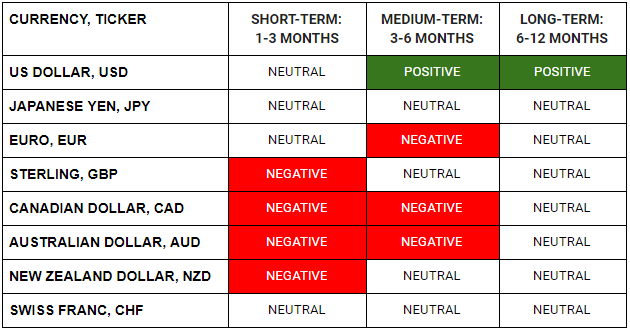WHAT HAPPENED YESTERDAY
As of New York Close 17 Mar 2020,
FX
U.S. Dollar Index, +1.36%, 99.40
USDJPY, +1.44%, $107.38
EURUSD, -1.48%, $1.1017
GBPUSD, -1.23%, $1.2117
USDCAD, +1.61%, $1.4243
AUDUSD, -2.09%, $0.5990
NZDUSD, -1.64%, $0.5947
STOCK INDICES
S&P500, +6.00%, 2,529.19
Dow Jones, +5.20%, 21,237.38
Nasdaq, +6.23%, 7,334.78
Nikkei Futures, +0.36%, 16,900.0
COMMODITIES
Gold Futures, +3.49%, 1,538.40
Brent Oil Futures, -4.03%, 28.84
SUMMARY:
As we’ve pointed out in our previous publications, there is a real Dollar shortage due to a cash grab and this is causing funding pressures, inadvertently strengthening the Dollar against all else. This is despite the Fed and other central banks opening up swap lines and may also help to explain the selloff in bonds as everyone struggles to find liquidity in a massive deleveraging.
The CAD finally woke up from its stupor and got on with the weakening game. It should continue to trade weakly as it bears the brunt of the double blow of lower oil prices and the negative economic impact of Covid-19 spread. The JPY regained its status as the numero uno widow-maker as risk aversion speculators get stopped trying to buy it and risk-seeking punters get stopped trying to sell it.
New Zealand announced a big fiscal stimulus package of worth 3.5% of GDP and the NZD spiked higher to above .6090s but the poor flightless bird could not stay up. Sellers eventually smacked it down to the low 0.5910s.
In markets, the S&P 500 rebounded 6.0% on Tuesday, as investors reacted positively to additional monetary stimulus measures and the possibility of an estimated $1 trillion fiscal stimulus package. The Dow Jones Industrial Average rose 5.2%, the Nasdaq Composite rose 6.23%, and the Russell 2000 rose 6.7%. (a caveat is that Index futures gave back all the gains right after the Close as bids could not hold). U.S. 2yr Yield rose 11bp to 0.47% and U.S. 10yr Yield rose 29bp to 1.02%.
The plan from the White House reportedly includes $500-550 billion for direct payments or tax cuts to Americans, $200-300 billion for small business assistance, and $50-100 billion for airline industry relief. The administration is also considering support for homeowners whose income was cut due to the Covid-19, according to Bloomberg.
The Fed, meanwhile, established a temporary commercial paper funding facility to help alleviate strains induced on commercial paper markets. Companies typically acquire short-term financing from this market. The Treasury Secretary approved the decision and will provide the Fed $10 billion in credit protection and the ability to purchase up to $1 trillion in commercial paper if needed. The initially spurred a rally in front end Eurodollar Interest Rates futures contracts (which means a dip in front end LIBOR 3months interest rates ie indicating some relief in funding pressure) but that was short-lived as markets deem the program too little and at not an attractive enough price.
However, what is key is that the mechanism is now in place, and the Fed and the US Treasury can adjust accordingly if more is needed to support the market. Make no mistake, they will do whatever it takes to prevent a credit crisis.
On a side note, Trump has resorted to tweeting about the “Chinese virus” per his playbook of blaming everyone else (especially foreigners) but himself for anything that goes wrong. This will not play well with the Chinese government and a spat between the two superpowers are counterproductive, especially in times like these.
TRUMP ‘GOING BIG’’ WITH $1 TRILLION STIMULUS AS U.S. COVID-19 DEATHS TOP 100
The Trump administration on Tuesday pursued a $1 trillion stimulus package that could deliver $1,000 checks to Americans within two weeks to buttress an economy hit by Covid-19, while New York said it might order its residents to stay home. U.S. stocks jumped on Tuesday, a day after their steepest declines since the 1987 crash, as the Federal Reserve took further steps to boost liquidity. The benchmark S&P 500 .SPX closed up 6%. Mnuchin said the government will keep the stock markets open but may shorten trading hours if necessary.
IMPACT: When pumping credit into the system doesn’t work, let’s fast track Modern Monetary Theory (MMT) and send em’ the money! The entire system is predicated on using money to solve issues. Well, that works when everything is hunky dory, but not anymore, as the wise sage says, “money is not everything”. What we are witnessing is a crisis of leadership (amongst other things).
CHINA EXPELS AMERICAN JOURNALISTS AS SPAT WITH U.S. ESCALATES
China withdrew the press credentials of American journalists at three U.S. newspapers on Wednesday, intensifying a fight between the two over the spread of Covid-19 and press freedoms. The dispute began in February when Beijing expelled three Wall Street Journal correspondents – two Americans and an Australian – after the newspaper ran an opinion column which called China the “real sick man of Asia.” China denounced the column as racist and after the newspaper declined to apologize, revoked the visas of the three reporters in Beijing. Another reporter with the paper had to leave last year after China declined to renew his visa.
A striking aspect of Beijing’s response was its decision to bar the journalists from working in Hong Kong and Macau, two semi-autonomous territories of China with their own media accreditation rules. In the past, foreign journalists kicked out of China were allowed to work in Hong Kong. This raised questions about Hong Kong’s autonomy under the “one country, two systems” agreement that still prevails between the territory and the mainland.
IMPACT: The U.S. and China are in a classic Thucydides trap, where a rising power threatens to disrupt an incumbent. Expect more volatile relations going forward as the virus escalates de-globalisation and will cause countries to rethink their supply chains.
FED LAUNCHES PRIMARY DEALER CREDIT FACILITY (PDCF) WHICH WILL ACCEPT STOCK AS COLLATERAL
U.S. Treasury Secretary Steven Mnuchin on Tuesday said he approved the creation of a new primary dealer credit facility to ease credit market disruptions caused by the Covid-19 epidemic, resurrecting the second 2008 financial crisis-era backstop in less than a day.
The facility, managed by the Federal Reserve Bank of New York, will offer loans up to 90 days to the two dozen Wall Street primary dealers who are important conduits for the sale of a broad range of bonds and other financial assets. Mnuchin said the primary dealer credit facility would be in place for at least six months and may be extended as conditions warrant. Earlier on Tuesday, Mnuchin approved a Fed backstop for the US$1 trillion commercial paper market, using US$10 billion from the Treasury’s Exchange Stabilization Fund
IMPACT: Desperate times calls for desperate measures. Credit extended to primary dealers under this facility may be collateralized by a broad range of investment-grade debt securities, including commercial paper and municipal bonds, and a broad range of equity securities. This means that as of this moment, equities – which are worth zero in a worst-case scenario – are eligible collateral for Fed liquidity. That said not all equities are eligible as collateral: “the following equities would not be eligible: exchange-traded funds (ETFs), unit investment trusts, mutual funds, rights, and warrants” For those who may not remember, the PDCF was one of the biggest bailout operations of the financial crisis when dealers abused the Fed as they pledged totally worthless stocks for which they got “par” value.
DAY AHEAD
The SNB meets tomorrow, but is the least likely of the three central banks to make any changes to its policy. At -0.75%, Switzerland already has the lowest interest rate in the world and although the country has been hit hard by Covid-19, the SNB has another weapon at its disposal – FX intervention. The SNB’s foreign exchange reserves were up slightly in February, indicating that it was intervening to keep the safe-haven Swiss franc down, particularly against the euro, as risk sentiment soured due to the virus outbreak.
SENTIMENT
OVERALL SENTIMENT:
Escalating numbers of infected cases and we still have many countries yet to do the testing vigorously, any improvement in sentiment will be temporary. The S&P 500 futures tested the 5% limit up level 4 times in Asian trading hours and could not hold there. Another rally came during NY hours and it managed to break that level but failed yet again. Price action tells you everything you need to know.
FX

STOCK INDICES

TRADING TIP
The Hibernating Bear Awakens…
I have been fielding many calls from people – friends and random people – who are curious/nervous about current markets. Their questions are invariably either of the following:
– When should I buy?
– Is it time to sell VIX, volatility, some hocus pocus bank product which essentially means you sell volatility?
This is a market conditioned to buy the dip and sell any spikes in volatility.
Volatility is high relative to historical records of volatility. Sure, it looks juicy to sell but when was the last time stock markets go up and down 5% a few times a day? Sure, it cannot last forever, and it didn’t in the past. When in the past, though, do you remember having such a pandemic sweeping across the world that requires every country to shut down and lockdown all their citizens?
Bear markets do not happen when all the bears are expecting them, they happen when every bear has decided to switch camp and buy the dips. You see now all the so-called experts are saying there is a high risk of recession. Some pundits are still calling it a slowdown.
If every country in the world is shutting for a few weeks and maybe even months, how are they going to generate enough production the rest of the year to make the numbers show growth vs the numbers last year?

